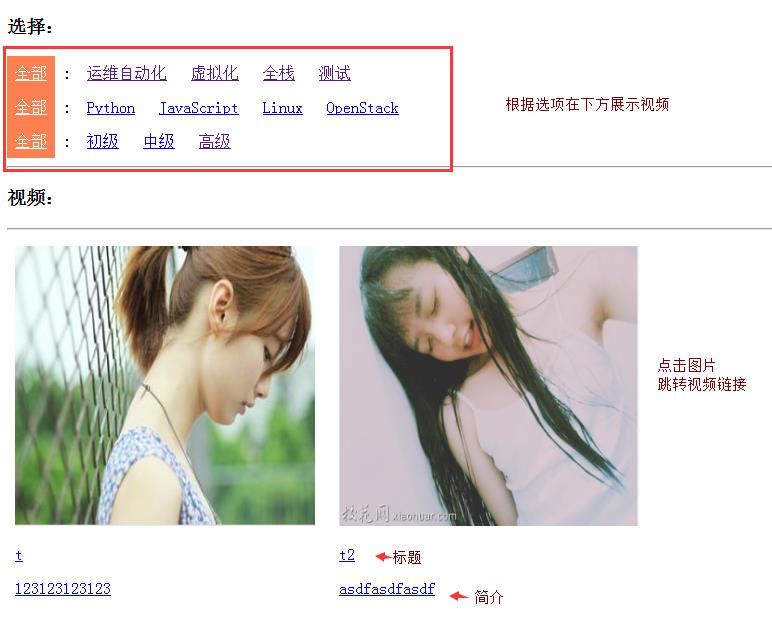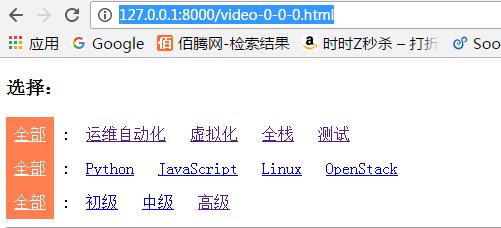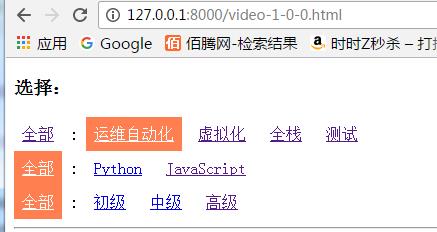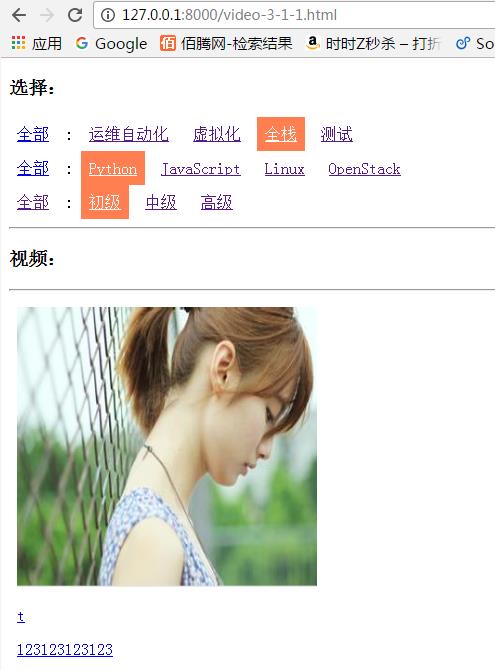关于django 京东淘宝 混合搜索实现原理
Posted py小蟒蛇
tags:
篇首语:本文由小常识网(cha138.com)小编为大家整理,主要介绍了关于django 京东淘宝 混合搜索实现原理相关的知识,希望对你有一定的参考价值。
混合搜索在各大网站如京东、淘宝都有应用,他们的原理都是什么呢?本博文将为你介绍它们的实现过程。
混合搜索的原理,用一句话来说就是:关键字id进行拼接。
混合搜索示例:

数据库设计:
视频方向:
|
1
2
3
4
5
6
7
8
9
10
11
12
|
class Direction(models.Model): weight = models.IntegerField(verbose_name=\'权重(按从大到小排列)\', default=0) name = models.CharField(verbose_name=\'名称\', max_length=32) classification = models.ManyToManyField(\'Classification\') class Meta: db_table = \'Direction\' verbose_name_plural = u\'方向(视频方向)\' def __str__(self): return self.name |
视频分类:
|
1
2
3
4
5
6
7
8
9
10
|
class Classification(models.Model): weight = models.IntegerField(verbose_name=\'权重(按从大到小排列)\', default=0) name = models.CharField(verbose_name=\'名称\', max_length=32) class Meta: db_table = \'Classification\' verbose_name_plural = u\'分类(视频分类)\' def __str__(self): return self.name |
视频:
|
1
2
3
4
5
6
7
8
9
10
11
12
13
14
15
16
17
18
19
20
21
22
23
24
25
26
27
28
29
30
|
class Video(models.Model): status_choice = ( (0, u\'下线\'), (1, u\'上线\'), ) level_choice = ( (1, u\'初级\'), (2, u\'中级\'), (3, u\'高级\'), ) status = models.IntegerField(verbose_name=\'状态\', choices=status_choice, default=1)#可用于管理员的审核 level = models.IntegerField(verbose_name=\'级别\', choices=level_choice, default=1) classification = models.ForeignKey(\'Classification\', null=True, blank=True) weight = models.IntegerField(verbose_name=\'权重(按从大到小排列)\', default=0) title = models.CharField(verbose_name=\'标题\', max_length=32) summary = models.CharField(verbose_name=\'简介\', max_length=32) img = models.ImageField(verbose_name=\'图片\', upload_to=\'./static/images/Video/\') href = models.CharField(verbose_name=\'视频地址\', max_length=256) create_date = models.DateTimeField(auto_now_add=True) class Meta: db_table = \'Video\' verbose_name_plural = u\'视频\' def __str__(self): return self.title |
备注:
- 视频方向Direction类和视频分类Classification多对多关系,即一个视频方向对应多个视频分类,一个视频分类也可以对应多个视频方向。——classification = models.ManyToManyField(\'Classification\')
- 视频分类Classification类和视频Video类是一对多关系,即一个视频分类对应多个视频
- 视频Video类中level_choice 与视频也是一对多关系,这里为了简化表关系,直接使用choices=level_choice来代替
混合搜索url设计:
默认url:

http://127.0.0.1:8000/video-0-0-0.html,其中第一个数字代表视频方向,默认0代表全部方向;第二个数字代表视频分类,默认0代表全部分类;第三个数字代表视频等级,默认0代表全部等级。
每一个a标签默认的url:
例如运维自动化:<a href="/video-1-0-0.html">运维自动化</a>,即视频方向的对应数字为1,视频分类和视频等级都为0,这样做的目的是为了将此url和用户当前url进行拼接,并跳转到新的url。
选择运维自动化后的url:

多选情况下的url:

前端html:
加载自定义simple_tag:
|
1
|
{% load xx %} |
注:
- xx:名为xx的py文件,里面包含自定义函数,方便html中进行调用
- 在app中创建templatetags文件夹,将xx.py文件放在templatetags文件夹下
关于自定义simple_tag的更多信息,详见下文。
css:
 css代码
css代码设置css目的,当用户选择视频方向、视频分类、视频等级时,加深对应a标签。
选择区域html:
|
1
2
3
4
5
6
7
8
9
10
11
12
13
14
15
16
17
18
19
20
21
22
|
<h3>选择:</h3><div> {% action_all current_url 1 %} : {% for item in direction_list %} {% action current_url item 1 %} {% endfor %}</div><div> {% action_all current_url 2 %} : {% for item in class_list %} {% action current_url item 2 %} {% endfor %}</div><div> {% action_all current_url 3 %} : {% for item in level_list %} {% action current_url item 3 %} {% endfor %}</div><hr /> |
该区域全部基于自定义simple_tag实现,详见下文。
视频显示区域html:
|
1
2
3
4
5
6
7
8
9
10
|
<h3>视频:</h3> <hr /> {% for item in video_list %} <a class="item" href="{{ item.href }}"> <img src="/{{ item.img }}"> <p>{{ item.title }}</p> <p>{{ item.summary }}</p> </a> {% endfor %} |
循环显示符合条件的全部视频。
自定义simple_tag:
全部标签的生成:
我们希望,当用户选择全部标签时,url对应位置为0,即当用户三个选择都是全部时,url为:/video-0-0-0.html
以视频方向为例介绍:
对应位置html:
|
1
|
{% action_all current_url 1 %} : |
从上述html可看出,action_all为对应的函数,它接收两个参数:当前url(current_url)、当前位置(视频方向、视频分类、视频等级)。其中current_url是后台传入html的,详见下文后台views函数介绍。
action_all函数:
|
1
2
3
4
5
6
7
8
9
10
11
12
13
14
15
16
17
18
19
20
21
22
23
24
25
26
27
28
29
30
31
32
33
34
|
#!/usr/bin/env python# -*- coding:utf-8 -*-from django import template from django.utils.safestring import mark_safe@register.simple_tag #注册simple_tagdef action_all(current_url,index): #接收当前url和对应的位置参数 """ 获取当前url,video-1-1-2.html :param current_url: :param item: :return: """ url_part_list = current_url.split(\'-\') #根据“-”进行分割 if index == 3: #如果是视频等级 if url_part_list[index] == "0.html": #如果选择的是全部 temp = "<a href=\'%s\' class=\'active\'>全部</a>" #添加 “active”属性 else: temp = "<a href=\'%s\'>全部</a>" url_part_list[index] = "0.html" else: if url_part_list[index] == "0": temp = "<a href=\'%s\' class=\'active\'>全部</a>" else: temp = "<a href=\'%s\'>全部</a>" url_part_list[index] = "0" href = \'-\'.join(url_part_list) #处理后的列表再拼接成url字符串 temp = temp % (href,) #生成对应的a标签 return mark_safe(temp) #返回原生html |
其它a标签:
以视频方向为例介绍:
对应位置html:
|
1
|
{% action current_url item 1 %} |
从上述html可看出:action函数接收三个参数 当前url、当前标签对象、当前位置。
action函数:
|
1
2
3
4
5
6
7
8
9
10
11
12
13
14
15
16
17
18
19
20
21
22
23
24
25
|
@register.simple_tagdef action(current_url, item,index): # videos-0-0-1.html # item: id name # video- 2 -0-0.html url_part_list = current_url.split(\'-\') if index == 3: if str(item[\'id\']) == url_part_list[3].split(\'.\')[0]: #如果当前标签被选中 temp = "<a href=\'%s\' class=\'active\'>%s</a>" else: temp = "<a href=\'%s\'>%s</a>" url_part_list[index] = str(item[\'id\']) + \'.html\' #拼接对应位置的部分url else: if str(item[\'id\']) == url_part_list[index]: temp = "<a href=\'%s\' class=\'active\'>%s</a>" else: temp = "<a href=\'%s\'>%s</a>" url_part_list[index] = str(item[\'id\']) ur_str = \'-\'.join(url_part_list) #拼接整体url temp = temp %(ur_str, item[\'name\']) #生成对应的a标签 return mark_safe(temp) #返回安全的html |
至此,所有选择标签生成完毕,能够根据用户选择动态生成url。
视频显示区域的前后端处理:
前端html:
|
1
2
3
4
5
6
7
|
{% for item in video_list %} <a class="item" href="{{ item.href }}"> <img src="/{{ item.img }}"> <p>{{ item.title }}</p> <p>{{ item.summary }}</p> </a> {% endfor %} |
循环显示所有符合条件的视频。
后端views函数:
|
1
2
3
4
5
6
7
8
9
10
11
12
13
14
15
16
17
18
19
20
21
22
23
24
25
26
27
28
29
30
31
32
33
34
35
36
37
38
39
40
41
42
43
44
45
46
47
48
49
50
51
52
53
54
55
56
57
58
59
60
61
62
63
64
65
66
67
68
69
|
def video(request,*args,**kwargs): print(kwargs) print(request.path) request_path = request.path #当前请求的路径 q = {} #从数据库获取视频时的filter条件字典 q[\'status\'] = 1 #状态为审核通过的 class_id = int(kwargs.get(\'classification_id\')) #获取url中的视频分类id direction_list = models.Direction.objects.all().values(\'id\',\'name\') #从数据库中获取所有的视频方向(包括视频方向的id和name) if kwargs.get(\'direction_id\') == \'0\': # 方向选择全部 print(\'方向等于0\') class_list = models.Classification.objects.all().values(\'id\', \'name\') #方向id=0,即获取所有的视频分类(包括视频分类的id和name) if kwargs.get(\'classification_id\') == \'0\': #如果视频分类id也为0,即全部分类 pass else: # 如果视频分类不是全部,过滤条件为视频分类id in [url中的视频分类id] q[\'classification_id__in\'] = [class_id,] else: print(\'方向不为0\') # 方向选择某一个方向, # 如果分类是0 if kwargs.get(\'classification_id\') == \'0\': print(\'分类为0\') obj = models.Direction.objects.get(id=int(kwargs.get(\'direction_id\'))) #获取已选择的视频方向 class_list = obj.classification.all().values(\'id\', \'name\') #获取该方向的所有视频分类 id_list = list(map(lambda x: x[\'id\'], class_list)) #获取所有视频分类对应的视频分类id q[\'classification_id__in\'] = id_list #过滤条件为视频分类id in [该方向下的所有视频分类id] else:#方向不为0,分类也不为0 obj = models.Direction.objects.get(id=int(kwargs.get(\'direction_id\'))) class_list = obj.classification.all().values(\'id\', \'name\') id_list = list(map(lambda x:x[\'id\'], class_list)) q[\'classification_id__in\'] = [class_id,] #过滤条件为视频分类id in [已经选择的视频分类id] print(\'分类不为0\') # 当前分类如果在获取的所有分类中,则方向下的所有相关分类显示 # 当前分类如果不在获取的所有分类中, if int(kwargs.get(\'classification_id\')) in id_list: pass else: print(\'不再,获取指定方向下的所有分类:选中的回到全部\')
|